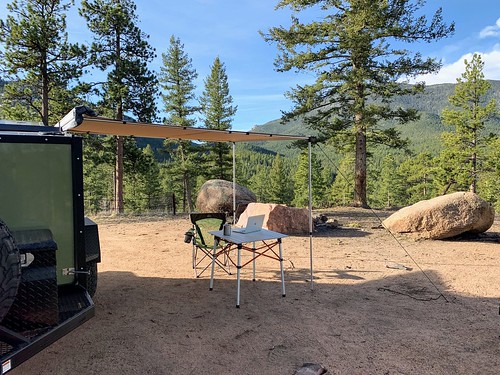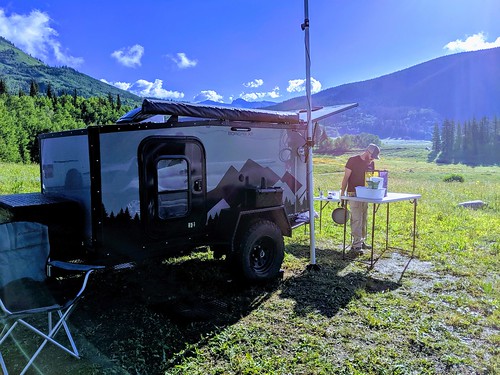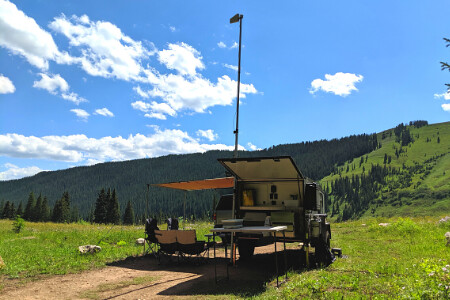PARTNER SPONSORED ARTICLE
May we present for your consideration: the backcountry work station. The Boreas Campers models are off-road ready teardrop campers, and there are only a few add-ons you need to make it the perfect basecamp for working remotely.
We spoke with two Boreas owners who have set up their overland campers to enable them to work remotely and travel, and asked them about the equipment they need, the pros and cons, and views from ‘the office’.
EQUIPMENT YOU NEED TO WORK REMOTELY AND TRAVEL
If you want to be able to travel while working remotely, having the right equipment is key. Since most remote workers rely on a good connection with the internet, you’ll need some extra support to get a signal in the backcountry. WeBoost offers a cell signal booster kit that is popular for this. With the set you get an outside antenna that pulls in the cell signal from the closest tower, a booster ‘brain’ to amplify this signal, and an inside antenna to distribute throughout the camper. Getting geared up to work from the road requires patience. Setting up the equipment can take some trial and error to find where the signal strength is strong or weak, and where it fits best. You’ll want the booster inside the camper so it’s safe from the weather, and the little antena has to be inside, and a certain distance away from the large antenna.
WHAT EQUIPMENT DO YOU USE TO WORK REMOTELY WHILE TRAVELING?
Darren is an engineer for a cloud provider based in Denver, CO. He has been a full time remote worker for 4 years, and part time for 10 years prior to that. Nick is a software developer who works from somewhere in the Rocky Mountains about 25% of the camping season. Darren: Laptop. Cellular repeater. A weBoost Drive 4G X Signal Booster. 25’ telescoping mast antenna. A small, portable monitor screen that plugs in with an HDMI to add additional screen real estate if you work with a lot of tabs open. Nick: Started with the weBoost Drive 4G X, but wasn’t getting more than 6” of range inside the trailer, so made a custom setup by assembling the Booster brain and power adaptor from the Drive X kit, wideband directional 50 ohm outdoor antenna, a desktop indoor antenna, and a 25’ telescoping antenna pole. (You can also find the mounts, bases and socket arms he used to attach everything to his Boreas in his detailed post on Expedition Portal.)

PICKING A LOCATION WHEN WORKING FROM THE ROAD
Once you have the equipment, there are some items to know before you go. First: location. Just because you have a signal booster doesn’t mean you can go anywhere. Basically a booster amplifies a signal, even if it is very weak. If there’s no signal, there’s nothing you can do. If you’re in the mountains, Nick recommends working from the road at higher elevations. Don’t go to a valley (where you probably won’t get a signal) and check that there’s a good line of sight to where towers are located.

Darren recommends downloading and checking Open Signal and RootMetrics, and Nick refers to Network Cell Info Lite (Android) and LTE Speed Coverage Map (iOS): all apps that help you identify what areas have a signal for different service providers. If you have the ability to set up devices on more than 1 service provider, you may have better luck with one than the other in certain areas. And community tip: make sure to run speed tests and share what service you did or didn’t get back into the app so the crowd-sourced information keeps improving. Apps like this are what make working remotely while traveling possible, so it's important to contribute to the community when you can.
Working remotely while traveling also requires a steady power supply so sunlight is critical! Since you’re using the panels to charge your laptop, signal booster, extra screen and phone in addition to the fridge in the Boreas, make sure they are in full sunlight. Nick added extra batteries to his setup and if you plan on spending extended time at your remote location you may want to consider that as well. Lastly, being in relative proximity to a store to restock on water and food supplies is handy. The camper can stay at base camp but it’s helpful to be close to a general store.
PROS AND CONS OF WORKING FROM THE BACKCOUNTRY
CONS:
- Good cellular coverage is required
- Need a personal strategy to stay disciplined
- Have to deal with weather that doesn’t follow forecasts, which may affect your tech equipment
PROS:
- Rolling out of bed and your office is the mountains
- Less distractions than in-home or the office
- Did we mention the views?

WHY BOREAS IS THE PERFECT RIG FOR WORKING FROM THE ROAD
Darren: ‘I tried tent camping while remote working but it just wasn’t feasible. The fridge and 20-gallon water capacity on the Boreas eliminates frequent trips to town, and being settled in a location with the things I need makes it possible to do my job well, even in the backcountry. Having the hard sided camper is key too when nasty weather rolls in.’
Nick: ‘The Boreas has no wood, is super rugged and a great construction. I know wherever I can go with my tow vehicle, the camper can come too. If you can be patient and understand it takes trial and error and exploring to see what you can find, then you will really enjoy working in the backcountry. And make sure you have good batteries.’ The Boreas off-road camper is the perfect way to make the backcountry your new work basecamp. If your job is considering keeping work from home going forward make sure to check out your local dealer to get you set up to work remote too!







